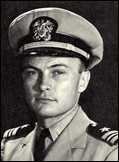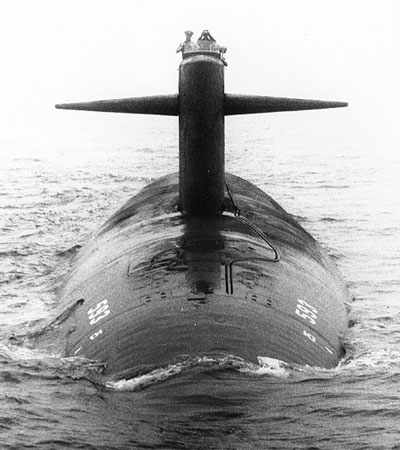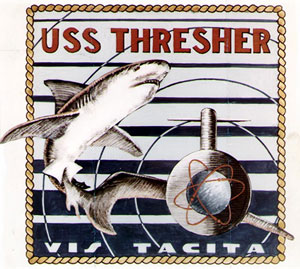The nuclear submarine USS Thresher was lost with all 129 hands 50 years ago today – April 10, 1963 – more than 200 miles off the New England coast during deep-dive tests. It had just departed Portsmouth Naval Shipyard in Kittery, Maine after a routine overhaul.
The Thresher was the ultimate attack submarine for its time, designed to hunt and destroy enemy vessels. It had a high-speed hull, the most powerful sonar in existence, special silencing features and advanced weapons, according to dozens of documents and news reports.
It could also dive deeper than any other submarine.
There are two ties to Vanderbilt University: Pat Garner and Steve Krahn. One lost. One a nuclear engineer passionate about keeping the memory of Thresher alive.

Lieutenant Commander Pat Mehaffy Garner perished that day. Garner, only 31, was promoted to that rank a full year ahead of his contemporaries. As Executive Officer, Garner was second in command aboard Thresher. He left behind a widow, Alice Stets Garner, and two daughters, Kathryn and Sarah Beth, of Mystic, Conn.
Garner had been commissioned an ensign through Vanderbilt’s Naval ROTC program after graduation in 1953, and the Memphis native was serving on his third submarine. Prior to his assignment to Thresher, Garner spent four and a half years aboard the submarine USS Skate, and took part in all three of its Arctic expeditions below the ice. While he was aboard, Skate earned two Navy Unit Commendations. Garner was aboard in 1959 when Skate became the first submarine to surface at the North Pole.

Thirty years after the Thresher tragedy Steve Krahn delivered the keynote address at the 1993 Department of Energy’s Standards Conference: The Loss of USS Thresher (SSN593): Lessons for the Development, Implementation, and Use of Standards.
Krahn, professor of the practice of nuclear environmental engineering, said the loss of the Thresher was a watershed event for the U.S. submarine force and it led to significant advances in submarine safety in design, construction and maintenance.
At the time of the conference Krahn was a senior executive staff member of the Defense Nuclear Facilities Safety Board. The DOE had asked the DNFSB to provide a keynote speaker.
“I was selected because I was a submarine-qualified Engineering Duty Officer, who also was nuclear qualified—a rare commodity,” he said. EDO’s are the corps of officers tasked with designing and maintaining Navy ships. Submarine-qualified EDO’s (known as “ED Dolphins”) are a small set of the EDO’s dedicated to the design, construction and repair of nuclear submarines. Very few submarine-qualified EDOs are also nuclear qualified.
Combined with his technical qualifications, Krahn had spent four years leading repair and maintenance on Thresher-class subs: First, as the Nuclear Ship Superintendent (Navy-speak for project manager) on the USS Greenling in 1984 and 1985. Then, as the Senior Ship Superintendent (senior project manager in charge of the entire $140 million overhaul) on the USS GATO from 1985-1987.
“After four years I knew every nook and cranny of the Thresher Class.”
Krahn reviewed the entire Navy and Congressional investigations in preparation for the keynote address. “The speech was exceedingly well received and has lived on in cyberspace,” said Krahn, who continues to study the loss of Thresher and its implications. “It has formed portions of articles I have written for peer-reviewed journals on the Naval Nuclear Propulsion Program, and I have been requested by NASA and the Sloan School at MIT, among others, to discuss the loss of Thresher and its implications for the management of technology.”
Krahn was associated with the Naval Nuclear Propulsion Program throughout a ten-year Navy career as a nuclear engineer in Naval Reactors organization. The Navy’s Commander of the Naval Nuclear Propulsion Program also is the Deputy Assistant Secretary for Naval Reactors in the Department of Energy. “It is a joint office and the two titles are often used interchangeably by those of us who served for ‘The Admiral’,” Krahn said.
Krahn was stationed at the Portsmouth Naval Shipyard years after the Thresher tragedy. “Every year on April 10 the Portsmouth Chapel bell rings 129 times,” he recalled.
The loss of the Thresher
“Thresher was the lead, or first, boat of a new class of nuclear submarines designed to go significantly deeper than previous classes,” Krahn said. “In July 1962, after nearly a year of record-breaking operations, Thresher returned to Portsmouth for an overhaul. In early April 1963, Thresher’s dock trials were completed and on April 9, Thresher was ready to put to sea.”
Krahn said the submarine was crowded, as is usual for sea trials. “In addition to the normal crew of 108 officers and men, 21 extra personnel from Portsmouth, the Fleet, and several technical contractors were shoe-horned in.” Thresher was headed for a rendezvous with the submarine rescue ship USS Skylark, which would accompany it during trials.

At about nine in the morning on April 10, Thresher signaled “Proceeding to test depth.”
At about 9:13 a.m. Thresher signaled that she was experiencing “minor difficulties,” that the boat had taken a positive angle (the bow was higher than the stern) and that the crew was attempting to blow main ballast tanks.
Krahn said no further intelligible message was received. “Only garbled fragments, in which the words “test depth” were the only discernable phrase.
At 9:18 a.m. – sounds identified by experience Skylark personnel as that of a submarine breaking up.
After further attempts to communicate with Thresher failed, the Fleet announced that the submarine was overdue and presumed missing.
A five-member Navy court heard 120 witnesses and collected 255 exhibits over eight weeks, most of it behind closed doors. Ultimately the evidence filled 1,718 pages bound into 12 secret volumes. In Congress the Joint Committee on Atomic Energy also conducted an investigation, some of it in secret, and issued a nearly 200-page report.
The Navy has declassified some information, but some of it remains secret. Krahn said the depth that submarines can go to is still classified.
He recommends a 1997 article in American Heritage’s Invention and Technology magazine by Dean J. Golembeski, “What Sank The Thresher.” He said anyone who would like to read further about submarines during the Cold War should give Blind Man’s Bluff by Sherry Sontag and Christopher Drew a look, and for story of subs in WWII try Clay Blair’s Silent Service.

Golembeski wrote, “What the investigations discovered, aside from the specifics of the disaster, was a catastrophic failure in the Navy’s basic approach to design, development, and testing. They pointed up a critical need for the creation and implementation of engineering standards that would be strictly observed, especially in the design and construction of complex and technologically sophisticated systems.
“The nuclear submarine was built using tried and true methods and procedures that had worked for decades. But with the adoption of new materials, equipment, and operating conditions, the old ways became suddenly, tragically inadequate.”
SUBSAFE is a direct legacy of the Thresher tragedy, Krahn said. SUBSAFE is the Navy’s nuclear submarine quality assurance and certification program designed to maintain the safety of the fleet. Since the program began in 1963, only one submarine, the non-SUBSAFE-certified USS Scorpion has been lost.
After leaving the Navy, Krahn worked at Perot Systems, which has been awarded a multimillion dollar comprehensive submarine support contract in 2002 by the Naval Sea Systems Command. The program encompassed engineering, management and technical services for the operation and maintenance of Trident strategic submarines and attack submarines; submarine depot maintenance; deep submergence programs; logistics and submarine training systems; and support of submarine safety and quality assurance and non-propulsion electronics system fleet integration and certification.
Krahn left Perot Systems in 2007 and spent three and a half years in nuclear jobs at the Department of Energy, culminating in his appointment as Deputy Assistant Secretary for Safety and Security in the Office of Environmental Management.
Steve Krahn came to Vanderbilt in 2010 to help create nuclear environmental engineering studies. “We started with Introduction to Nuclear and Environmental Engineering (ENVE 285) and we now have four graduate level classes and six Ph.D. candidates.”
A year ago Krahn presented a special topics lecture to civil engineering seniors. In his lecture – Pushing the Boundary of Technology: Lessons from the Loss of the USS Thresher – he cites Admiral Hyman Rickover, called the Father of the Nuclear Navy and an electrical engineer, who testified at the 1963 inquiry:
“I believe the loss of the Thresher should not be viewed solely as the result of failure of a specific braze, weld, system or component, but rather should be considered a consequence of the philosophy of design, construction and inspection that has been permitted in our naval shipbuilding programs. I think it is important that we re-evaluate our present practices where, in the desire to make advancements, we may have forsaken the fundamentals of good engineering.”
“I welcome any opportunity to talk about the Thresher,” Krahn said. “I’m passionate about it.”
Krahn delivered the lecture in April.